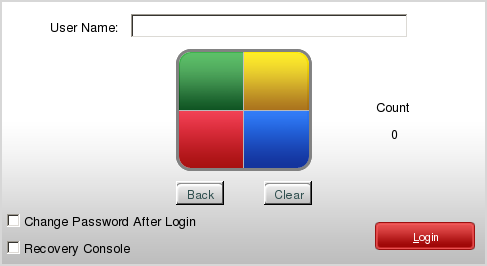Endpoint Encryption administrators and users have several
authentication methods to log on to Endpoint Encryption devices. The
methods available are determined by the PolicyServer policy configuration.
NoteYou must use PolicyServer MMC to configure the authentication methods available to
Endpoint Encryption users. It is not possible to
use Control Manager to configure the allowed
authentication methods. However, you can configure Control Manager for domain authentication.
|
Supported Authentication Methods
ColorCode
ColorCode™ is a unique authentication method designed for quick
access and easy memorization. Rather than alphanumeric characters or symbols for the
password, ColorCode authentication consists of a user-created color sequence (example:
red, red, blue, yellow, blue, green).

Domain Authentication
Endpoint Encryption integrates with Active Directory using
LDAP configured in PolicyServer. Endpoint Encryption domain
authentication allows Endpoint Encryption users to use
single sign-on (SSO) between the operating system and the Endpoint Encryption agent. For example, Endpoint Encryption users with domain authentication must
only provide their credentials once to authenticate to the Full Disk Encryption preboot,
log on to Windows, and access the files protected by File Encryption.
-
PolicyServer has joined the domain.
-
All Endpoint Encryption devices are in the same Active Directory and domain as PolicyServer.
-
The user names configured in Active Directory exactly match the user names configured in PolicyServer (including case).
-
The user names are located within a PolicyServer group and the Domain Authentication policy is enabled.
-
The host name and domain name are configured correctly based on the LDAP or Active Directory server settings.
NoteFor information about configuring LDAP and Active Directory
settings, see the Endpoint Encryption Installation
Guide available at:
|
Fixed Password
PIN
Remote Help
Remote Help allows Group or Enterprise
Authenticators to assist Endpoint Encryption users who are
locked out and cannot log on to Endpoint Encryption devices
after too many unsuccessful log on attempts, or when the period between the last
PolicyServer synchronization has been too long.
NoteRemote Help authentication is triggered by Endpoint Encryption device policy rules. Remote Help
policy rules are configurable in both PolicyServer MMC and Control Manager.
|
Self Help
Self Help
authentication allows Endpoint Encryption users who have
forgotten the credentials to answer security questions and log on to Endpoint Encryption devices without getting Technical
Support assistance. Self Help requires the Endpoint Encryption user to respond with answers to
predefined personal challenge questions. Self Help can replace fixed password or other
authentication methods.
Consider the following when choosing your authentication method or when
configuring Self Help:
-
Self Help is not available for Administrator and Authenticator accounts.
-
Self Help is not available for accounts that use domain authentication. PolicyServer is unable to change or retrieve previous domain passwords.
-
Self Help has a maximum of six questions for each user account. Users may be unable to log on using Self Help if more than six questions are configured.
-
Self Help is only configurable with PolicyServer MMC.
Smart Card
Smart card authentication requires both a PIN and a
physical token to confirm the user identity. Smart card certificates are associated
with
the user account and the user's assigned group. Once registered, the user can use
smart
card authentication from any Endpoint Encryption device in
that group. Users are free to use any Endpoint Encryption
device in their group and do not need to ask for another one-time password.
To use smart card authentication, make sure that the following requirements are
met:
-
The smart card reader is connected to the endpoint and the smart card is inserted into the smart card reader.
-
ActivClient 6.2 with all service packs and updates installed.

Note
ActivClient 7.0 and later is not supported. -
Specify the smart card PIN in the password field.

WARNING
Failure to provide a correct password sends a password error and may result in locking the smart card.
Note
|

